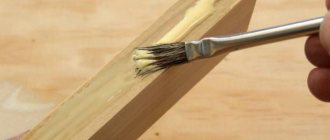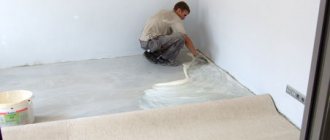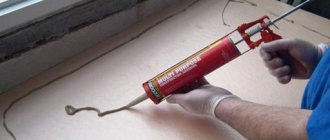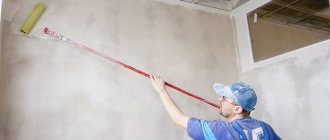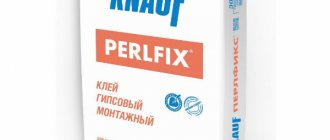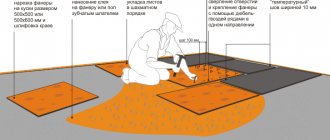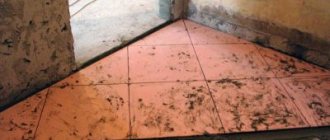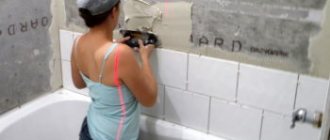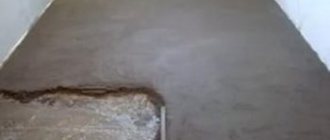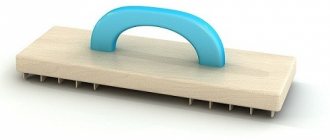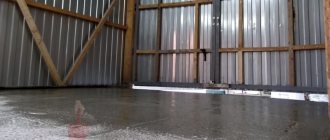Conclusion
I hope that this unique instruction will answer all your questions regarding the installation of thermal insulation materials. The video in this article will tell you about some important points in more detail, and if you have questions, ask them in the comments under the review.
To glue non-flammable mineral wool insulation to walls or ceilings, you should select high-quality and specialized adhesive for mineral wool slabs.
The seriousness of choosing an adhesive for gluing insulation to walls or ceilings lies in the fact that if you purchase the wrong adhesive, then in winter there will be a significant loss of heat.
As a result, this will lead to the need to completely replace the thermal insulation of the wall, which will significantly hit the budget. Therefore, it is necessary to purchase glue for mineral wool only from popular brands and based on the advice of experts. Note that it is not harmful.
Application
Before using the composition, thoroughly degrease and dry the surfaces. You can apply glue only from the mixer that is included in the package. The maximum mechanical strength of a polyethylene seam occurs after 4 or 5 hours. The optimal air temperature for work is from +21 to +23˚ C.
Advice: In its liquid state, the adhesive's shelf life is no longer than three minutes, so join the surfaces immediately after applying the composition.
It is not intended for gluing polyethylene surfaces, but the phenol-formaldehyde resin included in its composition has excellent adhesion to such material.
Application of epoxy glue:
- Rub the areas to be glued with sandpaper, degrease and dry.
- Treat the surfaces with chromic anhydride (concentration solution 15-20%) or potassium dichromate (20-30%). You need to work with them with extreme caution, as these substances are very caustic and are dangerous carcinogens.
- After treatment, dry the surfaces.
- Prepare epoxy glue according to the instructions on the package.
- Apply a thin layer of adhesive to both surfaces and immediately join them.
- Leave for several hours, or better yet, a whole day at a temperature of +30 to +45˚ C, so that the seam completely hardens.
Tip Chromic anhydride and potassium bichromate can be replaced with a strong solution of potassium permanganate, which is also a strong oxidizing agent. It is no less effective, but at the same time safer, although it can also leave a chemical burn.
- If very high demands are placed on the strength of the seam being formed, then the optimal method for gluing polyethylene is welding. The seam will be strong if it is not allowed to cool suddenly.
- Before using filled acrylate adhesive, no mechanical preparation of the surface is required. With the exception of degreasing and cleaning, which are carried out before gluing any surfaces.
- The seam formed after gluing the film with acrylate glue should be kept at a temperature from +15 to +70˚ C for 4-5 hours.
- Epoxy glue is difficult to work with, and the bond strength is not very good.
Tip You can create your own recipe for polyethylene glue by adding a little crushed chalk or cement to the acrylate glue. The composition can be of high quality and at the same time inexpensive.
The best option for gluing polyethylene is welding, since the result is a strong, reliable seam. It is not always advisable to use adhesive compositions, this is explained by the fact that polyethylene is a chemically inert material with weak adhesive properties.
This problem is often faced by owners of summer cottages, greenhouses, home craftsmen, and even car owners. After failures, people start looking for information on the topic. Is it even possible to glue polyethylene? In the article you will find the answer to this question.
Features of penofol fastening
Penofol (isolon) is produced by special foaming of polyethylene. The insulation is covered with aluminum foil, which maximizes heat retention. It is used for internal and external work, in finishing production mechanisms, preserving heat in pipelines or air conditioning systems. It comes in rolls and individual plates. It may have additional characteristics – thickness, color. The bonding of foil to the plane of foamed polyethylene can be chemical or physical (cross-linked).
Pros of penofol:
- small thickness;
- environmentally friendly;
- does not require additional skin and respiratory protection;
- there is no need for special tools;
- ease of fastening.
We attach penofol to glue (click to enlarge)
Glue is used for penofol with foil on one side.
Double-sided insulation is used for thermal insulation of loggias, garages, and pipes. They are attached to the sheathing or purchased polyethylene foam with a self-adhesive surface.
Due to the lightness of the insulation material, the load-bearing capacity of the adhesive is not so important.
Glue selection
The range of adhesives for penofol on the modern market is quite wide. Therefore, it is important to take into account the different characteristics of materials.
General rules
Penofol adhesive is selected based on the following:
- the product has durable adhesive properties;
- the thermal range coincides with the temperature characteristics of the insulation;
- a non-toxic certified product is used in the interior decoration of residential premises (apartment, office);
- for external finishing, you need glue that is resistant to temperature changes and weather conditions;
- saunas and baths require mixtures with water-repellent properties;
Watch the video to understand better:
Water-based glue is not suitable for gluing isolon!
A water base will not create the required level of penetration into all the pores of foil polyethylene foam. The grip on the surface will be insufficient.
Types of glue
You can select glue according to the table (click to enlarge)
Choose what to glue with, also evaluating the surface:
- Weicon Easy-Mix PE-PP 45. Bonds polypropylene and polyethylene. It hardens for a long time;
- Titanium. Optimal for concrete base;
- Atlas Stopter K-20 glue. Adheres to mineral substrates;
- T-Avangard-K is used at high humidity;
- Contact Acrol or Neoprene-2136 spray is glued to penoplex;
- Ceresit and Olfix are universal - they are attached to any surface, including concrete;
Atlas Stopter K-20 glue would be a good choice (click to enlarge)
The seams are treated with Tilite or special tape.
How to glue foamed polyethylene (polyethylene foam)
Penofol
Photo 1. Gluing foil insulation on the balcony
How and what to glue
Usually, the balcony is first insulated with polystyrene foam boards, onto which foil polyethylene is glued.
To do this, you can use the following glue:
- QUICK-BOND
- 88-NP
- Akrol contact
- spray "Neoprene 2136"
The joints are sealed with metallized tape or overlapped.
You can glue the foam to the foam or to another surface using the following glue:
- CEREZIT ST83
- ANSERGLOB BCX 39
- AQUALIT SK-106 P (polymer cement mixture)
- MASTER SUPER
- POLYMIN P-20
- STOLIT PC and TYTAN STYRO 753 O2 (aerosol polyurethane)
For example, to insulate a home, you need to glue the screen behind the radiator.
The required size of foil polyethylene foam is cut out. Penofol with polished aluminum foil 3-5 mm is usually used.
The screen can be secured with double-sided tape or glued.
Photo 2. An example of gluing Izolon reflective insulation behind a heating radiator
The wall must be cleaned, treated with an antiseptic, dried and leveled if necessary.
We recommend the following glue for this:
- 88 Luxe
- Nairit-1 (88-P1)
- Foam rubber-2 (88-P2)
- 88-Metal
Photo 3. Universal adhesive 88 for polyethylene foam (polyethylene foam)
Today, it is the most popular adhesive on the market due to its versatility and wide application. Retains its properties in the range from -30C to 90C, and is used both in everyday life and on an industrial scale.
To use it correctly, carefully study the instructions for using the glue; it has a large number of varieties.
For large volumes of work, glue is available in packages starting from 25 kg.
Such as for example:
- adhesive mixture "Facade"
- BOLARS
To purchase products and receive advice in this area, call: 38, 38 (093) 246-22-24
Penofol adhesive is selected taking into account the surface to which the heat insulator will be fixed.
Fig.1 Penofol on a concrete balcony structure
Penofol is foamed polyethylene covered with aluminum technological foil. Installation of the canvas is not difficult due to the lightness of the material. It is used not only in construction. It is excellent for thermal and sound insulation of machine units.
But how to glue penofol to concrete? After all, this is a very unstable material, having high thermal conductivity, heat capacity and even the ability to accumulate moisture.
To fix insulation to hard brick or concrete surfaces, the adhesive must have a number of properties:
- Have a high degree of adhesion and hygroscopicity;
- Do not destroy the material;
- Be resistant to weather conditions;
- Withstand large temperature changes;
- Have fungistatic and antiseptic properties;
- Do not lose their properties over time.
We invite you to familiarize yourself with the Three by Five Bathhouse
For the best fixation of any material, special solvents are added to the glue. They create a certain porosity of the bonded surfaces. Moreover, there are no universal solvents; each material requires its own.
But, for example, penofol can reliably stick to penoplex without solvents.
If you are insulating a bathhouse or sauna, then when choosing an adhesive you need to pay attention to its heat resistance and resistance to water vapor.
Fig.2 Fixing penofol on metal structures
An important property is environmental safety, especially when using material for interior decoration. Only certificates of conformity can refute the toxicity of glue. Imported manufacturers often use toxicity certificates under the abbreviation EMICODE.
The method of using the penofol adhesive method is simple and cost-effective. The insulation is very light, which means it does not require the application of a large amount of adhesive. When fixing to metal, you should make sure that there is no water base in the composition, otherwise it will cause significant corrosion of the surface and damage to the insulation itself.
The surface for gluing penofol must be smooth and free of dust. Concrete walls or floors must be plastered without cracks, and metal surfaces must be treated with an anti-corrosion coating.
The glue is applied to the surface of the penofol not protected by foil in an even layer. All areas of the insulation must be coated. Particular attention is paid to the edges of the panel.
Before fixing the penofol, wait a few seconds to 1 minute so that the glue dries a little. This will ensure its best adhesion. Afterwards, the canvas is pressed to the surface, holding it, and gently smoothed until it is completely fixed. The seams between pieces of insulation can be coated in advance or after finishing the entire surface.
How and what to glue
Penofol
How to attach penofol
Attach penofol with the foil side facing the inside of the room. A greater thermal insulation effect is created by an additional air layer 1-2 cm thick (using a backing - sheathing).
By watching the video you will learn more:
Glue of different compositions for polyethylene foam can be ready-made or requires preparation on site. You must carefully read the instructions for the selected mixture:
- The glue is applied in an even layer, paying special attention to the edges. Before sticking, you need to wait up to 1 minute so that the composition has time to be slightly absorbed. This ensures better adhesive properties. Attach the treated penofol to the insulated surface. The plates are fastened joint to joint, but not overlapping;
- setting time varies depending on the characteristics of the glue (at least 15 seconds);
- smooth the surface of the polyethylene foam, removing folds. Tape the seams, you can use foil tape;
- glued insulation in residential premises requires additional decorative finishing. The last layer of the structure (plasterboard or lining) is installed on the sheathing.
Nothing brings satisfaction more than a job done correctly and skillfully. If you follow all the recommendations, attaching the insulation will not cause much trouble.
Dew point shift with different thermal insulation locations
And yet, why do most craftsmen offer facade rather than internal insulation, since it is much more convenient to work from the inside, especially when a new building is being built? I'm talking about this not because there is a specific instruction that obliges you to install thermal insulation on the outside, but because this is actually common sense.
Although in some situations, internal insulation is the only possible, and therefore the most acceptable.
Pay attention to the figure above - it shows the dew point formation zone. In other words, this is condensation with and without thermal insulation in different positions.
As you understand, condensation forms when warm air collides with a cold surface. And since the atmosphere is saturated with moisture, under certain conditions it turns from steam into water, that is, into dew drops.
If the insulation is located from the inside, then the dew point falls either on the gap between the wall and the insulator, or on the body of the wall. But both are bad, since dampness accumulates on the surface, and conditions for its destruction are created in the wall itself.
In those cases where the insulation is located outside, the wall does not cool to the dew point. Therefore, if you choose the thickness of the insulation in accordance with the coefficient of your region, then this zone will shift to the insulation itself, which is not at all dangerous.
I hope I have convincingly made it clear to you, dear readers, that it makes more sense to insulate rooms from the outside rather than from the inside.
Glue and its purposes
The adhesive can be universal, but it can also be intended specifically for a specific material - for foam plastic, extruded polystyrene foam, mineral basalt wool and reinforcing mesh. When choosing a composition, pay attention to the packaging - there are always instructions for use and preparation instructions.
| Name of glue | Styrofoam | Extrud. expanded polystyrene | Basalt wool | Reinforcing mesh | Weight (kg) |
| Creisel 210 LEPSTYR | + | — | — | 25 | |
| T-85 SILTEK | + | — | + | — | 25 |
| T-87 SILTEK | + | — | + | — | 25 |
| Baumit NivoFix | + | — | + | — | 25 |
| MOMENT PPP | + | + | — | + | 25 |
| POLIMIN P-19 | + | — | + | — | 25 |
| Creisel 220 STYRLEP | + | + | + | + | 25 |
| BAUMIT DuoContact | 25 | ||||
| POLIMIN P-20 | + | — | + | — | 25 |
| Kreisel 230 KLEBEMORTEL | — | — | + | — | 25 |
| POLIMIN P-21 | + | + | + | + | 25 |
| BAUMIT ProContact | + | — | + | + | 25 |
| BAUMIT StarContact | + | + | + | + | 25 |
| Creisel 240 GEWEBEKLEBR | — | — | + | — | 25 |
| Ceresit ST 83 | + | — | — | + | 25 |
| Ceresit CT 85 | + | — | — | + | 25 |
| Ceresit ST 83 pro | + | — | — | + | 25 |
| Ceresit ST 85 pro | + | — | — | + | 25 |
| Ceresit ST190 pro | + | + | + | + | 25 |
| Master THERMOPOLISTYRENE | + | — | — | — | 25 |
| Master THERMO | + | — | + | — | 25 |
Table of application of adhesives
One of the most expensive compounds - BAUMIT Star Contact
In the table, not every adhesive has a + in the “reinforcing mesh” column, indicating that such adhesive can be used to fix the reinforcement, since this is not specified by the manufacturer. But from personal experience I can say that almost all mixtures are capable of holding such a mesh well, and you will not need to choose another brand for this. The cost of a particular composition depends on its scope, but the highest price is usually from BAUMIT StarContact (in the spring of 2016 it was about 6.3 - 6.5 $).
Facade insulation
Before gluing polystyrene foam, extruded polystyrene foam, basalt wool, or even self-adhesive insulation, you need to prepare the surface. The fact is that any glue requires adhesion (this is the essence of the process), but if there is dust or loose plaster on the surface, then adhesion will turn into cohesion.
In addition, you will need to seal the cracks and under no circumstances begin insulation if the house is in disrepair (subsidence, cracking, etc.) - all your work will be in vain.
To correctly determine the insulation power, you need to know the factor for your region and for the materials used.
Polystyrene foam and extruded polystyrene foam are glued to the wall according to the principle: the working side of the panel is partially or completely smeared and pressed against the insulation object. This measure cannot be neglected - additional fastening (fungi-dowels) will not be enough.
These are not empty words. I saw with my own eyes how a strong wind “divided” a nine-story building within 3 minutes, because the finishers neglected the glue, or rather, they did not use it enough.
At first, the wind tore off only one corner panel at the eighth floor level, but then strong gusts of wind reached the rest. Since there were many gaps between the foam and the wall, a strong air flow began to penetrate these cracks and tear off the insulation.
Only the first floor and partly the second were not damaged, since closer to the ground the wind force was less - it was extinguished by the surrounding buildings and trees.
Additional fastening - dowel mushroom
After you glue the panels, secure them additionally with special dowels - their cap is made in the shape of a mushroom. A hole is drilled in the wall using a hammer drill, then a dowel is inserted and a nail from the kit is hammered into it. The depth of immersion into the wall should be at least 5c, so choose the appropriate length of the mushroom.
After installing foam or extrusion, you will need a facing finish (most often, this is decorative plaster) and for this you need to reinforce the insulation. Apply glue to the surface with a notched trowel, straighten it and place the mesh there.
After that, press it with a trowel or grater. After drying, you can begin applying decorative plaster.
For mineral wool, additional fasteners such as dowels are rarely installed, so the glue must be applied with a comb to the entire surface, as shown in the photo above.
If you still use dowel mushrooms for basalt wool, then the mixture can be applied to it pointwise. The fact is that cotton wool is used for frame finishing, therefore, it will not be subject to heavy loads, since it is protected from the wind.
It should be said that insulated laminated veneer lumber or a solid wooden profile require the same adhesives.
Preparatory work
First, you need to properly prepare the concrete for gluing, which will ensure a monolithic, uniform connection. They eliminate all defects, unevenness, cover up cracks, repair chips, and thoroughly clean the surface from dirt and dust. Cover the base with a primer and wait until it dries completely. All metal elements must be treated with an anti-corrosion compound.
Gluing stage
The glue is applied to the side without foil in a thin, even layer, spreading evenly over the entire surface. The edges are impregnated with glue as thoroughly as possible so that the penofol does not lag behind the concrete surface. The insulation must be held for 10-40 seconds so that the adhesive composition can set and fix the sheet to the surface more efficiently. Next, the sheet is pressed against the concrete, carefully smoothed, distributed evenly, additionally gluing the seams.
Choosing a suitable adhesive for gluing penofol to concrete is a very important task that must be approached seriously. It is advisable not to skimp on the composition, since the strength, reliability, and durability of the fixation will depend on its compliance with the requirements and operating conditions.
